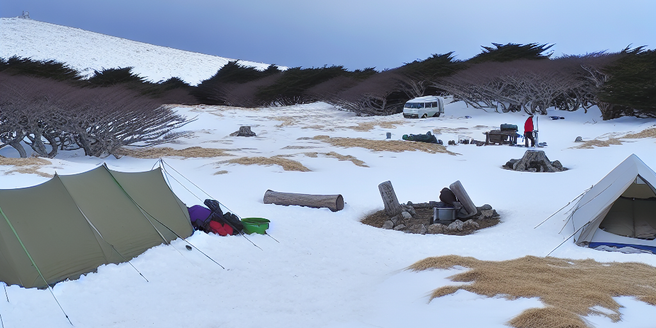
Choosing the Perfect Campsite
Choosing the perfect campsite is a critical factor in setting up your winter camp. It should ideally be on level ground, sheltered from wind but not directly under trees as falling snow or branches might be a danger. Furthermore, it should not be near any avalanche-prone slopes to ensure your safety. It also needs to be a safe distance from any water bodies to avoid the risk of flooding. You should also look for a site that has a good exposure to sunlight during the day as this can also provide some warmth. Additionally, checking if the area allows for easy access to firewood is crucial as fire keeping warm is necessary in winter.
Preparing the Essential Camping Gear
Preparing your camping gear is an integral part of setting up camp. Ensure you have a tent that’s built to withstand winter conditions. A good tent not only provides shelter but also warmth during the freezing nights. A sleeping bag rated for winter temperatures, a sleeping pad for insulation from the cold ground, and a camping stove for heating water and cooking food are also essential. In addition, having a good quality camping chair can offer great comfort after a day of hiking. Remember also to pack the necessary navigation tools, a first aid kit, and camping lights.
Building a Safe and Efficient Campfire
Campfires can be incredibly valuable to campers if built correctly, providing warmth, light, and a unique method of cooking food. To experience these benefits, one must understand how to correctly establish and manage a campfire. Selecting a safe location for the fire is crucial, preventing potential accidents and respecting the natural environment. Starting the fire involves the use of appropriately sized kindling and firewood in a controlled manner. An equally vital part in enjoying a campfire is ensuring it’s completely extinguished before leaving the site or going to sleep, preventing wildfires and maintaining safety. Lastly, remember that a good campfire is a result of thoughtful choices and respect for nature’s safety guidelines.
Winter Camping Clothing: What to Wear
Preparation is crucial for winter camping and selecting the right attire is essential. Choose carefully considering insulation and protection against the cold. Layer your clothes appropriately: a moisture-wicking base layer, insulating middle layer, and a weather-resistant outer layer. Clothing can be adjusted for temperature changes and activities. A base layer is critical for moisture control, and middle layers such as fleeces or down-filled jackets trap heat. An outer layer should repel snow, wind, and prevent cold air from reaching the insulated layers. A warm hat, gloves, waterproof boots are vital for protecting extremities from frostbite or hypothermia. Thus, with the right clothing choice in layers and proper care of extremities, you can have a comfortable, safe winter camping adventure.
Food and Water: Planning Your Meals
Embarking on a winter camping expedition requires thoughtful preparation, particularly when packing food and water provisions. It’s essential to carry more supplies than you may think are needed as your body’s demands increase in cold conditions. High-protein and high-fat foods such as nuts and dried fruits provide dense energy to replenish the body’s fuel and are reliable and portable. In addition to well-stocked food, mechanisms purifying water like purification tablets or portable water filters, are crucial. Despite the appearance of ample snow, dehydration is common in winter because the cold weather suppresses your sense of thirst. Hence, consuming enough water is critical for maintaining bodily functions, preserving body temperature and facilitating movement, proving vital for survival and wellbeing in the cold.
Staying Safe: Key Safety Tips for Winter Camping
Safety should be your top priority when winter camping. Always tell someone your plans before you go, and check the weather forecasts. This information should include your expected location, time of departure and return, and any significant stops you plan to make. Regularly check in with your contacts back home, so they know you’re safe. Not only does this keep them informed, but it can also be crucial should an emergency occur. Be aware of the signs of hypothermia and frostbite. Make sure you have a well-stocked first aid kit and know how to use it. Be cautious of wildlife and always keep your campsite clean to prevent attracting animals.
